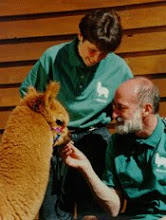
Those of you who live where it doesn't snow, or doesn't snow very much...skip to one of our other blogs, because this one is only for those who live where winter is truly winter!
2011 marks our 15th year raising alpacas, and every single one of those years has involved snow. One thing we have learned...it pays to have a snow management plan.
In fact, a snow management plan is just as important, perhaps more so, than a manure management plan. When it's below freezing outside and the white stuff is stacking up, how you move it and where you put it can be the difference between an easy winter and sheer hell (pardon our French!).
I like snow better than rain because I can move snow around and get it out of my way, and, with the proper equipment and clothing, I can even play in the snow, something I am rarely tempted to do with rain. But I have learned that snow has a way of making life ten times more difficult if you don't think ahead when you start to move it.
Here are some things I've learned about moving snow.
1) Figure out where to put snow. The first few storms are no big deal, but by February the snow piles are taller than we are. If we put the initial piles too close to the barn, house, garage, paths and roadways, we run out of stacking space. Better to have to move the snow farther at the beginning of winter so you'll still have somewhere to store more snow at the end of the season.
2) Snow becomes ice with no warning. Where you walk or where the animals walk can become lethal if you don't make sure to clear down to the ground whenever weather permits. If things warm up, it's important to remove as much slushy melting snow as you can. That way when things chill down again, your paddocks and walking paths won't be as dangerous to you and the animals.
3) Piles of snow melt. And then freeze, creating ice rinks where the melt water pools. A rule of thumb: stack snow downhill and down wind from any place you want to use during the winter.
4) Wind + snow = Ugh! Drifts! Piles of snow become drift points, so make sure you are not creating a monster. Stack snow so that the wind will not unstack it when your back is turned.
5) Shovel while you can. If the weather permits, get out and remove snow. The longer you wait, the heavier it gets. Moving wet or compacted snow is like moving shovels full of wet sand - extremely heavy and hard to throw very far. The best time to remove snow is right after it falls, when it is still light and fluffy.
6) Don't forget to stop and smell the roses, or, in this case, throw a snowball or two, make a snow angel or just admire the way snow sparkles in the sunlight. While snow adds to the work load, it also covers up a multitude of sins and makes the world look clean and bright. Plus, it is like time-release rain.
So enjoy the white stuff while you have it, for all too soon we'll be sweating in the heat of July and wishing for a sudden snowstorm to cool things off!



No comments:
Post a Comment